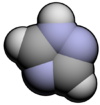1,2,4-三唑
化合物
1,2,4-三唑(作為配體時簡稱Htrz)是三唑的異構體之一,化學式 C2H3N3,有一個由兩個碳原子和三個氮原子組成的五元環。1,2,4-三唑及其衍生物有多種應用。[1]
| 1,2,4-三唑 | |||
|---|---|---|---|
| |||
| IUPAC名 1H-1,2,4-Triazole | |||
| 識別 | |||
| CAS號 | 288-88-0 | ||
| PubChem | 9257 | ||
| ChemSpider | 8900 | ||
| SMILES |
| ||
| InChI |
| ||
| InChIKey | NSPMIYGKQJPBQR-UHFFFAOYAZ | ||
| ChEBI | 46077 | ||
| 性質 | |||
| 化學式 | C2H3N3 | ||
| 摩爾質量 | 69.07 g·mol−1 | ||
| 外觀 | 白色固體 | ||
| 密度 | 1.439 g/cm3 | ||
| 熔點 | 120—121 °C(248—250 °F;393—394 K) | ||
| 沸點 | 260 °C(533 K) | ||
| 溶解性(水) | 非常易溶 | ||
| pKa | 10、3 | ||
| pKb | 11、8 | ||
| 相關物質 | |||
| 相關化學品 | 1,2,3-三唑 咪唑 | ||
| 若非註明,所有數據均出自標準狀態(25 ℃,100 kPa)下。 | |||
結構和性質 編輯
1,2,4-三唑是一種平面型分子。它的C-N和N-N鍵都在132至136皮米的範圍內,與芳香性一致。[2]儘管可以設想1,2,4-三唑有兩種互變異構體,但實際上只有一種存在。
1,2,4-三唑是兩性的,在水溶液中可以N-質子化和去質子化。1,2,4-三唑釒翁離子 (C2N3H4+) 的 pKa為2.45,而中性1,2,4-三唑的pKa 為10.26。[3]
製備和存在 編輯
1,2,4-三唑類可以通過艾因霍恩-布倫納反應或佩利扎里反應製備。沒有取代基的1,2,4-三唑可以由硫代氨基脲被甲酸酰化,然後把產物1-甲酰基-3-硫代氨基脲環化成1,2,4-三唑-3(5)-硫醇,最後用硝酸或過氧化氫氧化,產生1,2,4-三唑。[5]
1,2,4-三唑類化合物在多種藥物中均有使用。[6][7]一些值得注意的三唑類包括抗真菌藥氟康唑和伊曲康唑。[8]1,2,4-三唑陰離子在配位化學中是一種常見的橋接配體。[9]
參考資料 編輯
- ^ Potts K. T. The Chemistry of 1,2,4-Triazoles.. Chemical Reviews. 1961, 61 (2): 87–127. doi:10.1021/cr60210a001.
- ^ Jeffrey, G. A.; Ruble, J. R.; Yates, J. H. Neutron diffraction at 15 and 120 K and ab initio molecular-orbital studies of the molecular structure of 1,2,4-triazole. Acta Crystallographica Section B Structural Science. 1983, 39 (3): 388–394. doi:10.1107/S010876818300258X.
- ^ Garratt, Peter J. 1,2,4-Triazoles. Comprehensive Heterocyclic Chemistry II. 1996: 127–163. ISBN 9780080965185. doi:10.1016/B978-008096518-5.00080-0.
- ^ Grosjean, Arnaud; Négrier, Philippe; Bordet, Pierre; Etrillard, Céline; Mondieig, Denise; Pechev, Stanislav; Lebraud, Eric; Létard, Jean-François; Guionneau, Philippe. Crystal Structures and Spin Crossover in the Polymeric Material [Fe(HTRZ)2(TRZ)](BF4) Including Coherent-Domain Size Reduction Effects (PDF). European Journal of Inorganic Chemistry. 2013, 2013 (5–6): 796–802 [2021-10-11]. doi:10.1002/ejic.201201121. (原始內容 (PDF)存檔於2021-11-05).
- ^ C. Ainsworth. 1,2,4-Triazole. Organic Syntheses. 1960, 40: 99. doi:10.15227/orgsyn.040.0099.
- ^ Keri, Rangappa S.; Patil, Siddappa A.; Budagumpi, Srinivasa; Nagaraja, Bhari Mallanna. Triazole: A Promising Antitubercular Agent. Chemical Biology & Drug Design. 2015, 86 (4): 410–423. PMID 25643871. doi:10.1111/cbdd.12527.
- ^ Kaur, Ramandeep; Ranjan Dwivedi, Ashish; Kumar, Bhupinder; Kumar, Vinod. Recent Developments on 1,2,4-Triazole Nucleus in Anticancer Compounds: A Review. Anti-Cancer Agents in Medicinal Chemistry. 2016, 16 (4): 465–489. PMID 26286663. doi:10.2174/1871520615666150819121106.
- ^ Kathiravan, Muthu K.; Salake, Amol B.; Chothe, Aparna S.; Dudhe, Prashik B.; Watode, Rahul P.; Mukta, Maheshwar S.; Gadhwe, Sandeep. The biology and chemistry of antifungal agents: A review. Bioorganic & Medicinal Chemistry. 2012, 20 (19): 5678–5698. PMID 22902032. doi:10.1016/j.bmc.2012.04.045.
- ^ Haasnoot, Jaap G. Mononuclear, oligonuclear and polynuclear metal coordination compounds with 1,2,4-triazole derivatives as ligands. Coordination Chemistry Reviews. 2000,. 200-202: 131–185. doi:10.1016/S0010-8545(00)00266-6.

